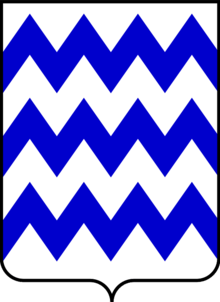Tocco family

The family of Tocco (plural in Italian: Tocci or Tocchi (source: Del Regno di Napoli, Scipione Manzella, 1601, in Greek: Τόκκοι) was a noble house from Benevento of Longobard origins, which in the late 14th and 15th centuries came to prominence in western Greece as rulers of the Ionian Islands, County palatine of Cephalonia and Zakynthos and the Despotate of Epirus.[1]
History
The Tocco family likely originated from a Lombard aristocrat named *Tokko under either the Kingdom of the Lombards or southern successor states Duchy of Spoleto or Duchy of Benevento. The first prominent member of the family is Ugolino Tocco, Grand Seneschal of Henry VI, Holy Roman Emperor in 1195.[2]
The first Tocco to settle in Greece was Guglielmo Tocco, appointed governor of Corfu in the 1330s under the Angevin ruler Philip I of Taranto.[1] His son Leonardo I Tocco was named Count palatine of the islands of Cephalonia and Zakynthos by Robert of Taranto in 1357, and succeeded in expanding his rule over Ithaca and Lefkada, as well as the port of Vonitsa on the Greek mainland, until his death in ca. 1376.[1][2][3]
His two sons were Carlo I Tocco and Leonardo II Tocco, the central characters of the early 15th-century Chronicle of the Tocco, written in Greek, which extols their exploits.[4] Leonardo received Zakynthos as an appanage. His daughter, Maddalena Tocco, was the first wife of Constantine XI Palaiologos, the last Byzantine emperor. Carlo, through his marriage with the daughter of Nerio I Acciaioli, Duke of Athens, was able to seize Corinthia in 1395, and conquered Elis sometime after 1402, although the former quickly fell to the Despot of the Morea, Theodore Palaiologos, and the latter was lost to the Moreote Byzantines in 1427.[1][5] Carlo also took advantage of a civil war among the Albanian chieftains of Aetolia-Acarnania to seize Acarnania by 1408, and in 1411 he succeeded his uncle Esau de' Buondelmonti as ruler of Ioannina. By 1415 he gained control over Arta as well, unifying the core lands of the Despotate of Epirus for the last time.[1][6]
After Carlo I's death in 1429, his realm was disputed amongst his five illegitimate sons and his adopted heir, his nephew Carlo II Tocco (the son of Leonardo II). At the behest of the former, the Ottomans intervened in the conflict, seizing Ioannina in 1430, and most of the rest of Epirus in the next year. Carlo II continued to rule from Arta as an Ottoman vassal until his death in 1448.[1][7] In the next year, Arta fell to the Ottomans. Carlo's son Leonardo III Tocco moved to Angelokastron; when it too fell in 1460, he fled to his family's possessions in the Ionian Islands, which he ruled there until 1479, when they too were captured by the Ottomans.[1][7] Leonardo and his family then fled to the Kingdom of Naples. Starting from his son, Carlo III Tocco, his descendants continued to style themselves titular Despots of Arta until the 17th century.
Following the death of Carlo II, at least one of his surviving sons, or possibly a grandson, had entered Ottoman service: Karlizade Ali Bey ("Ali Bey, the son of Carlo") whose descendants continued to perform military duties for the Ottoman sultans into the 16th century. Ali's Christian name is unknown, but he was either the half-brother or one of the nephews of Leonard III. Under Mehmed the Conqueror, Ali Bey was appointed as a tutor to the Sultan's son, Cem, who would later lose the war for the throne to his older brother Bayezid II. It is likely that Ali Bey had played a part in the negotiations between Cem and the Knights of St John based in Rhodes that precipitated the defeated prince's sojourn in Western Europe. Despite his close association with Cem, Ali Bey was able to protect his estates in the Ottoman Empire under the rule of Bayezid II and even funded the building of a mosque in 1485 at the Bulgarian town of Karlovo, which derives its name from the Karlizade family.[8]
References
- 1 2 3 4 5 6 7 Kazhdan (1990), p. 2090
- 1 2 Miller (1908), p. 292
- ↑ Fine (1994), p. 354
- ↑ Kazhdan (1990), pp. 446, 2090
- ↑ Fine (1994), pp. 431, 434, 543
- ↑ Fine (1994), pp. 356–357, 543
- 1 2 Fine (1994), pp. 544, 563
- ↑ Boykov, Grigor. ""Karlizade Ali Bey: An Ottoman Dignitary's Pious Endowment and the Emergence of the Town of Karlova in Central Bulgaria." Journal of Turkish Studies 39 (2013), 247-267".
Sources
- Fine, John Van Antwerp (1994). The Late Medieval Balkans: A Critical Survey from the Late Twelfth Century to the Ottoman Conquest. Ann Arbor: University of Michigan Press. ISBN 978-0-472-08260-5.
- Kazhdan, Alexander, ed. (1991). Oxford Dictionary of Byzantium. Oxford University Press. ISBN 978-0-19-504652-6.
- Miller, William (1908). The Latins in the Levant: A history of Frankish Greece (1204–1566). New York: E.P. Dutton and Co.